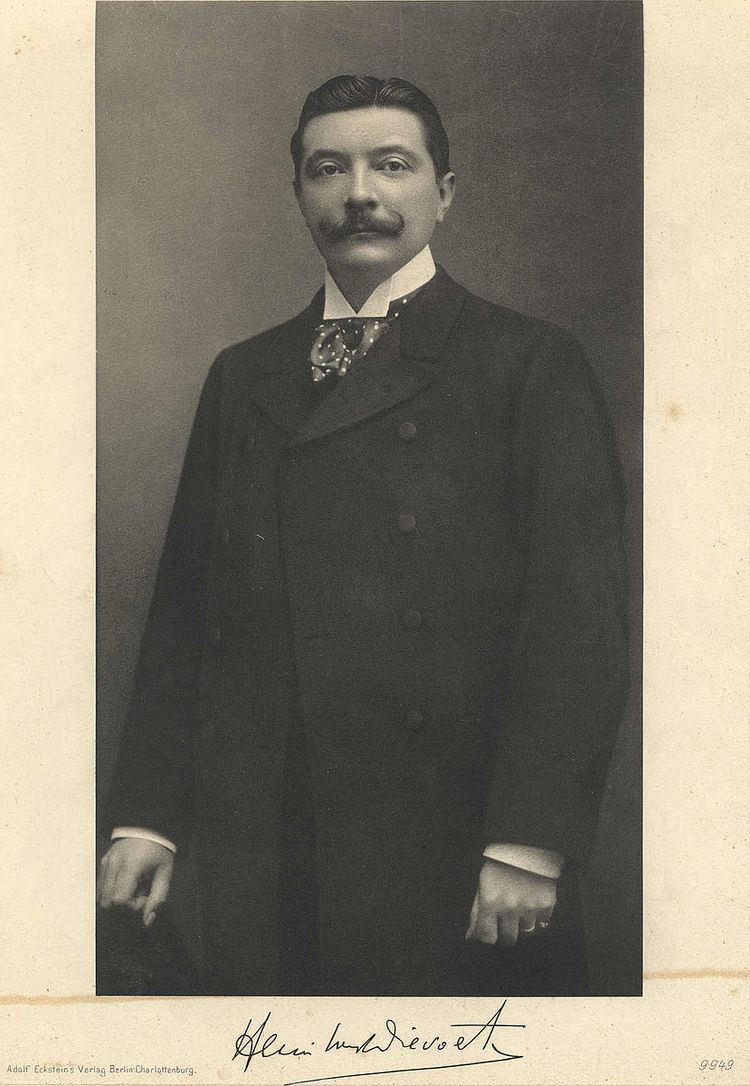Occupation Architect Role Architect | Name Henri Dievoet Children Germaine Van Dievoet | |
 | ||
Born 19 January 1869 ( 1869-01-19 ) Brussels Died April 24, 1931, City of Brussels, Belgium | ||
Henri van Dievoet (19 January 1869, Brussels – 24 April 1931) was a Belgian architect.
Contents
Biography
Van Dievoet belonged to an old family of Brussels descended from the Sweerts family, one of the Seven noble houses of Brussels, which had already shone in the fine arts of the time of Louis XIV. His great-great-uncles were the goldsmith Philippe van Dievoet and the sculptor Peter van Dievoet, one of the creators of the Grand Place of Brussels. Joseph Poelaert was his great-uncle.
He married Eugenie Ernestine Clemence Hortense Masson in Ixelles on 2 October 1894. She was born in Ixelles on 9 July 1872, daughter of Captain Stanislas Jean Ernest Masson, knight of the Ordre of Leopold, and Marie Eugenie Louise Clemence Mounoury. His first construction project (1889) was the house and workshop of the artist Felix Rodberg, 30 rue Washington, in Ixelles.
In 1890 he participated in the Salon d' Architecture de l'Exposition des Beaux-Arts de Bruxelles alongside Victor Horta and of Maurice Van Ysendijck.
In 1894 he won the Grand Prix of architecture of the Town of Brussels for his project "House of Parliament for a constitutional country".
In 1901, he conceived a series of buildings with apartments on Campenhout Street in Brussels. Other works include a house and studio for artist Felix Rodberg in Washington Straat (1889); the Evangelical Church in Haine Saint Paul Jolimont (1890); four houses on the rue General Patton (1895); the Royal Military Academy on the Avenue de la Renaissance, with fellow architect Henri Maquet (1908); and the Hotel Astoria, Rue Royale (1909).
Among his disciples appears Joseph Van Neck, who worked as draftsman in his workshop.
Positions held
He was for many years the secretary of the Central Societe of Architecture of Brussels.
Starting in 1910, he was professor with the Academie Royale des Beaux-Arts in Brussels.
From 1924 to 1931, From 1924 to 1931 he taught architectural drawing and perspective at the Academy of Fine Arts in Saint Gilles.
Family
His son, Paul Van Dievoet (born Brussels, 23 August 1896, died Schaerbeek 7 September 1947), was architect for the municipality of Schaerbeek, but also produced private work.
His daughter, Germaine Van Dievoet (born Brussels 26 September 1899, died 30 October 1990 at Uccle), was a championship swimmer who took part in the 1920 Summer Olympics in Antwerp.
Henri Van Dievoet was the brother of the famous decorator and modern-style sgraffitist Gabriel Van Dievoet (1875–1934), whose works still decorate many frontages of Brussels.
He also had a sister, Louise van Dievoet, born in Brussels on 3 November 1880, died in Paris on 26 December 1964. who married Andre Gachassin-Lafite, Viscount of Orthez, Chevalier of the Legion of Honor, captain to the 3rd regiment of Hunters of Africa (quartered with Constantine, Algerie). He was Military Assistant-Attache with the Embassy of France with Brussels, then Member of the High Commission of the Ministry for the War near the factories Schneider, Creusot (1915–1918).
End of his life
Henri van Dievoet died forgotten and, besides his close family, there was little of the outside world at his funeral: only his friend Victor Horta attended his burial, which took place in Brussels Cemetery in Evere. He is buried in the large central alley, n° 218, under a simple cross.
His work
His work marks the urban landscape of Brussels:
In Hasselt, he drew the designs for the National Bank.
Works of other architects Van Dievoet
Several members of van Dievoet's family were also architects.
